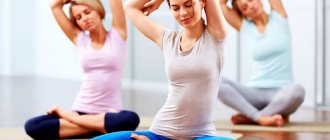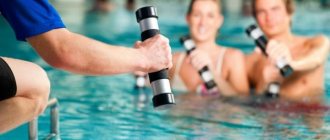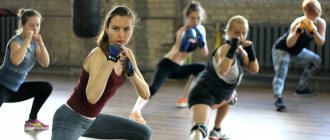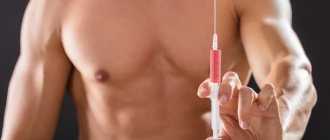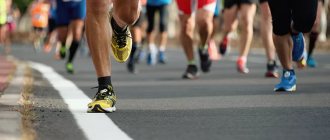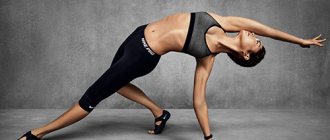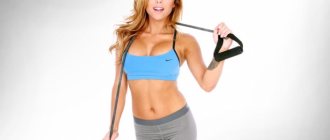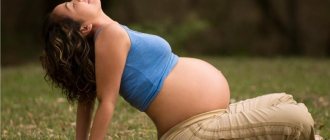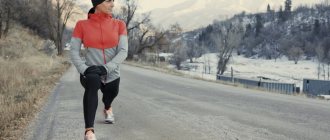Aerobics - a great way to be in good athletic shape, have a toned, slender body and radiate self-confidence! This is the key to activity and good mood, regardless of gender and age.
The word "aerobics" means "with oxygen." These are exercises that are vigorous and invigorating, last long enough, and are done regularly to keep the heart and lungs healthy. Typically performed in groups with an instructor and background music. This article discusses the concept of “aerobics” (what it is, its varieties, what are the benefits of exercise) and provides brief historical information. Interest in aerobics has been growing at lightning speed since the first days of its inception. An audience interested in good health and a beautiful body understands all its benefits. This type of exercise burns fat faster than any other type of exercise.
Exercises
The set of exercises includes walking, running, jumping, and flexibility exercises. The result of regular aerobics is keeping the body in good shape, training muscles and skin, and overall improvement of the body. Used for preventive and therapeutic purposes.
A combination, or composition, is a dance using the basic elements of aerobics, performed synchronously by a team of 8, 6, 3 people, a man-woman pair or solo. The duration of the sequence, from 1 minute to 3.5 minutes, is established by the rules of a particular event.
The main components of the ligament: jack, lunch, skip, jump, knee/knee-up, step, run, chasse, mamba, overlap, forward swing (kick, kick), swing to the side (side, side), heat (tap) and others.
Dance elements are physical exercises or jumps, the number of which is determined by the competition rules and the category to which the team belongs.
Elements of dance in the category “health aerobics”
- push-ups on the knees;
- balance (standing on one leg, not bent at the knee, motionless, tilting the body parallel to the floor and straightening the second leg and the opposite arm horizontally so that they form a straight line with each other and with the body);
- pistol corner (raising one leg horizontally to the floor on your arms with your abdominal muscles, holding the other leg on your shoulder);
- “fold” (bringing the upper body together with the legs, sitting on the floor, with straightened knees and pointed toes);
- women's twine;
- “step-up” jump (a jump from two legs, spreading them out to the sides as much as possible, as soon as the stretch allows, and bringing them back in the air, landing on two legs together);
- “horse” or “kangaroo” jump (jump from two legs while simultaneously pulling the knees to the chest).
Sports aerobics
- push-ups while lying down, push-ups while lying down with your elbows back;
- corner of the legs together (horizontal raising of the legs above the floor on the hands with the abdominal muscles for 4 or 8 counts);
- rotation of the angle by 90, 180 and 360 degrees;
- "horse";
- step-up (a jump from two legs at the same time, using the muscles of the legs and abs, spreading the legs in the air as far as stretching allows, while bringing the legs almost to the horizontal with some “folding” of the body forward);
- "fold";
- crawling through the splits, swing and others.
The number of elements and the degree of their implementation depends on the age and sports category of the team.
There are recreational aerobics, sports and recreational aerobics, and sports aerobics. There is also basic aerobics (without additional equipment and elements), step aerobics (using a step platform), fitball aerobics (aerobics on fitballs).
Aerobics in the USSR
| This section is missing references to information sources. Information must be verifiable, otherwise it may be questioned and deleted. You may edit this article to include links to authoritative sources. This mark was set on November 21, 2014 . |
| This article may contain original research. Add links to sources, otherwise it may be set for deletion. More information may be on the talk page. (November 21, 2014) |
| Check information. It is necessary to check the accuracy of the facts and reliability of the information presented in this article. There should be an explanation on the talk page. |
In the Soviet Union and Russia, from 1984 to 1992, 14 rhythmic gymnastics complexes were shown on Central Television.
- In 1984, the program debuted on screens with an episode hosted by the famous figure skater Natalia Linichuk. Performers: Elena Novozhilova, Zhanna Smirenina, Kaleria Studenikina, Irina Cherichenko, Dmitry Mishakov, Nikolai Tugov. Composer A. Kiriak, the introductory song is performed by Sergei Minaev.
- The second edition of aerobics was conducted by the no less famous ballerina Liliya Sabitova; it was shown on television from January to March 1985. The complex used melodies from the Dutch group “Stars on 45”. Performers: Elena Bukreeva, Alla Pravdina, O. Savelyeva, Kaleria Studenikina, Nikolai Tugov, Yuri Shcherbakov.
- The third complex of rhythmic gymnastics was taught by the Honored Master of Sports in artistic gymnastics Elena Bukreeva (March - April 1985). Composer: Jean-Michel Jarre (France). The running melody is “Time for business, time for fun” from the repertoire of Alla Pugacheva. The melody before the final part is “Who is to Blame” by Viktor Reznikov with a phonogram by Valery Leontyev. Performers: Elena Novozhilova, Alla Savchenko, E. Samsonova, Kaleria Studenikina, Nikolai Tugov, Yuri Shcherbakov.
- The host of the fourth complex was theater and film actress Elena Skorokhodova (May - June 1985). In this release, the music of the first three complexes was used, except for running (“The world around us is a complete confusion” by Hightower and Denny), lying down and an invigorating ending. Performers: Elena Bukreeva, I. Kolokolova, Alla Pravdina, Alla Savchenko, A. Ignatiev, Nikolay Tugov.
- The fifth edition of rhythmics was conducted by two presenters at once - Natalia Linichuk and Igor Bobrin. This is the first complex in which exercises in a standing position are divided into two parts: warm-up and the main part. The release was unusual in that the exercises were performed not only in gyms, as in previous complexes, but in nature (July - August 1985). Filming took place at the Dynamo Sports Palace, Izmailovsky Forest Park and on the bicycle track in Krylatskoye. Natalia Linichuk: “The first exercise is the left hand up, the right hand on the belt, one-two…”. For the first time, the sound range of the complex was presented entirely by compositions of one author - Z. Liepins (“Hard Nut” - warm-up, “Hard Nut-2” - the main part, “Hard Nut-2” (the sound is muted) - an episode with learning the exercises of the main part, “Shuttle” - running part (after warm-up), “Renaissance” - pulse check, final part, “Stars Again” - beginning, main part (first two exercises), sitting and lying exercises). A song performed by Vladimir Dubinin and the group “Ri. The fragment with learning the exercises of the main part at the beginning of the release
.
Now on the Internet this fragment is placed after
the main part, which is irrational. Performers - an experimental rhythmic gymnastics group led by Igor Bobrin, I. Kolokolova, L. Lomakina, Alla Pravdina, Alla Savchenko, B. Ivliev, A. Ignatiev, Nikolai Tugov, the ballet group of Alla Pugacheva (there is a version that the last participant with a braided oblique in a yellow-lilac dress - her daughter Kristina Orbakaite, although at that time she was 14 years old and it is unlikely that she took part in the filming). - The presenter of the sixth complex was again Elena Bukreeva (October - December 1986). The composer for this release is Chris Kelmi. Performers: L. Lomakina, Tatyana Onischuk, Alla Pravdina, O. Savelyeva, Alla Savchenko, E. Plotkin, Yuri Shcherbakov.
- The seventh complex was led by Igor Bobrin, classes were held both in the hall and outdoors in the winter season (January - March 1987). The author of the music for this complex is also Chris Kelmi. Voice-over: Elena Bukreeva. Performers: A. Antonova, E. Vasyukova, N. Karamysheva, O. Filippova, I. Lisovsky, I. Okunev.
- The eighth episode of aerobics was hosted by Natalia Efremova (Korkh) - the debut took place in May 1987. Performers - T. Kolomyets, N. Opletaeva, V. Palladyeva, L. Prokhorova, G. Rozovskaya, Svetlana Rozhnova, N. Serafimova, A. Ilchinin, B. Maslov, B. Opletaev, A. Semikov, children Lisa and Ilya ( children of presenter Natalya Efremova), at that time members of the children's ensemble “Kukushechka”.
- The ninth rhythmic complex was conducted by Svetlana Rozhnova, it is called “On the Sea”: aerobics classes are held in the southern resort of the Black Sea coast of the Krasnodar Territory - in the Dagomys microdistrict. The composer of the release is Vadim Lashchuk, leader of the Kyiv rock band “Display”. At the beginning of the complex, a short rap “Plasticity is gymnastics” was heard, which became the motto of this complex, and in the middle, in the running part, the song “The Joy of Movement” was played. The complex had an application that was broadcast on the Good Morning program - morning warm-up. There is information that the complex has been cut down (a white background is used in learning, as in the sixth complex). Performers: Alexandra Vasilyeva, Elena Zakharova, Tatyana Onischuk, Olga Mergeeva, Irena Cherne.
- The tenth episode broadcast on CT was “Apartment” (March - April 1989). Four presenters from previous editions took part in it: Natalia Efremova, Liliya Sabitova, Elena Bukreeva and Svetlana Rozhnova. It used the melodies of popular foreign disco hits. Performers are Natalia Efremova’s children Ilya and Lisa. Here Ilya has grown up, he is 5 years old. Filming took place at the VDNKh pavilion. This complex also had an application, which Natalya Efremova ran together with her son Ilya, in which they learned exercises specifically for children. Sergey Cheskidov interviewed the presenters while learning the exercises. At the beginning of the complex, Natalya Efremova was sorting out letters from fans of the program. There is information that the complex was cut down (Ilya learned to study in the living room).
- The eleventh aerobics complex (in the American style) was led by Svetlana Rozhnova and the then famous film actor Oleg Knysh. He appeared on television in May 1990. Also in June 1990, three additional complexes were shown, the presenters of which were constantly changing: the first - all participants in turn with Oleg Knysh, the second - Oleg Knysh, the third - Inna Ignatova. Performers: Elena Makaenkova, Victoria Tereshchenko, Tatyana Zimanova, Svetalana Semenova, Andrey Bobykin, Sergey Kondrashov.
- The twelfth complex was held against the backdrop of Russian nature to Russian folk melodies arranged by Yuri Poteenko. The presenter of the issue was Inna Ignatova (July - September 1990). Performers: Alla Dorofeeva, Tatyana Zimanova, Elena Makaenkova, Galina Meshcheryakova, Svetlana Semyonova, Victoria Tereshchenko, Oleg Knysh.
- The thirteenth complex was filmed in the USA. The host of this complex was Jane Fonda, with voice-over translation into Russian by Inna Ignatova (July - August 1991). This episode was broadcast until the collapse of the USSR.
- The fourteenth edition (June 1992) was conducted by the author of the set of exercises, choreographer, candidate of pedagogical sciences Olga Ivanova. Performers: Elena Makaenkova, Nikolay Shvachkin, Tatyana Mishurova, Elena Trush, Tatyana Zimanova, Svetlana Semyonova. The complex was again filmed in American style and became the last. Broadcast on Channel 1 Ostankino, it was not popular.
Since 2005, the complexes have been periodically repeated on the Nostalgia TV channel, with the exception of episodes from 8 to 14.
Music for aerobics
In 1983, Electrola released an album by the Aerobic Sound Band, entitled “Aerobic - Dancing”. The album is made in the form of non-stop disco[1]. Break Dance were released in 1984 and 1986.
and
Break Dance 2
by the Romanian group Electric-Cord Group, recorded in synth-pop and funk style.
In 1985–1986 she released a series of records “Sports and Music” with instrumental electronic music. It includes the following albums:
- “Rhythmic gymnastics” (announcer - Olga Chipovskaya, music performers - pop orchestra under the direction of Pavel Ovsyannikov, instrumental ensemble of Rosconcert under the direction of Vladimir Osinsky, instrumental ensemble "Radar" under the direction of Sergei Pedersen, VIA "Opus" under the direction of Sigmar Liepins , Vadim Kondratyev, Andrey Rodionov and Boris Tikhomirov)
- "Pulse-1. Musical computer" (authors and performers of music - Andrey Rodionov and Boris Tikhomirov)
- “Pulse-2” (music performer - VIA “Opus” under the direction of Sigmars Liepins)
- "Pulse-3" (music performer - jazz-rock band "Arsenal" under the direction of Alexey Kozlov)
- "Aeroton" (music performer - instrumental ensemble of Rosconcert under the direction of Vladimir Osinsky).
In 1988, the album of the same name by the studio duo “Display” was published, the participants of which were Kiev musician Vadim Lashchuk and his wife Ellen Kreis. The instrumental piece “Ten Thousand Meter Race,” which occupied the second side of the record, was used in the ninth edition of rhythmic gymnastics “On the Sea.” Also in this program his song “The Joy of Movement” is heard. Previously it was assumed that Lashchuk himself acted as the disc jockey, but in fact it was a DJ from Sochi, Alexander Gorbunov.
For aerobics, specially recorded music is used without gaps between songs (tracks). Typically the duration of the disc is 50-60 minutes, at the end a composition for stretching and relaxation is added. For each type of aerobics, music of different intensity (frequency) and style is used. For example, for step aerobics, the impact is usually 130-136, 132-138 beats per minute, for box aerobics - 135-145 and higher.
History[edit | edit code]
Usually the term “aerobics” itself is associated with the name of the American actress Jane Fonda. She made great efforts to spread dance aerobics throughout the world. However, in fact, this term was coined in the 60s of the twentieth century by the American physiologist Kenneth Cooper. His book Aerobics was published in 1963. A dance variety of aerobics also already existed before Fonda began to popularize it. Cooper himself emphasized the large role of the American dancer Jackie Sorrensen in her development. Cooper’s aerobics was known all over the world, but in relatively narrow circles - among trainers, lovers of health-improving techniques, etc. While Jane Fonda, being a world “star,” was able to spread dance aerobics among the “broad masses.”
Data
- Aerobics exercises are demonstrated by the Turtle in the cartoon “Treasure”.
- Footage of aerobics was shown during the performance of the song “Jim Observes the Daily Routine” (“Song about the Benefits of Sports”) in the cartoon “Treasure Island.”
- The passion for aerobics was ironically played out in the plot of the film magazine “Yeralash” “Breathe Deeply!” [2] and in the video for the VIA “Ariel” song “You are old, old people” [3].
- In 1983, the song “Aerobics” was released (music by Y. Krupnik, lyrics by S. Kutanin). The song was performed by the Chisinau VIA “Arta” and VIA “Ariel”[4].
- One of the aerobics exercises appears in the song "Luck" from the 1985 TV musical film One for All. Nikolai Karachentsov sings.
- A song about aerobics (music by A. Dergachev, lyrics by V. Levin) is heard in the children's film “Malyavkin and Company” (1986)[5][6].
- In the film “The End of Operation Resident” (1986), Olga Kostrova (actress Irina Rozanova) performs a set of exercises that is shown on TV (the third set with Elena Boukreeva).
Where to start[edit | edit code]
If you are a beginner or poorly prepared physically, study for several months in a preparatory group and only then move on to classes with more complex programs. In large groups, little attention is usually paid to proper technique, so the training either does not bring any benefit, or the effect is such as overtraining. The fact is that the instructor is not able to keep track of everyone and establish contact with each participant. If you have any physical problems that may be aggravated by exercise, you should inform the group leader in advance so that he can select safe and effective exercises for you. Read more: group fitness.
